Evidence that Economic Freedom Improves Outcomes
The latest Economic Freedom of North America report issued by the Fraser Institute marks the first time economists have had a full four decades’ worth of data on economic freedom across the fifty United States. Those less familiar with economic research claim that economics isn’t a science because economists can’t conduct controlled experiments. Yet where economists can’t conduct controlled experiments (behavioral economists do conduct controlled experiments), they employ complicated statistical techniques to compensate for the fact that they must take data as they come. Here, the Fraser Institute has given economists a treasure-trove of data that provide insight into the effect of larger and smaller government footprints among the states’ economies.
Economic freedom is not the same as less government. In fact, in many cases, improved economic freedom requires more government. Economic freedom is rather “right government,” government that, as Thomas Jefferson put it in his first inaugural address, would “restrain (people) from injuring one another, (but) shall leave them otherwise free to regulate their own pursuits…” Societies are more economically free when their governments prevent people from harming each other, whether by violence, theft, fraud, defamation, pollution, or any of the many other ways the more powerful manage to exploit the less. But societies are also more economically free when their governments otherwise leave people and businesses alone to make decisions for themselves. Exploitation is as anathema to economic freedom as is the nanny state.
There is no perfect way to measure economic freedom, as is often the case, so economists must settle for reasonable measures. Fraser has constructed a quasi-objective measure of economic freedom. The “quasi” part comes from the fact that Frasier’s researchers had to decide what metrics were consistent with the idea of economic freedom. The “objective” part is that government agencies put numbers to the metrics. In calculating an Economic Freedom index for each state, Fraser combines state and local government spending, government transfers and subsidies, state pension payments, tax rates and brackets, the minimum wage relative to average income, and government employment. Fraser simply averages its metrics together and puts the result on a scale from 0 (least free) to 10 (most free). Reasonable people can argue that some metrics should be weighted more than others, but Fraser tries to keep its researchers’ opinions out of the equation by taking simple averages.
As of 2020, the last year for which Fraser has performed the calculations, economic freedom among the fifty states has ranged from a low of 4.3 (New York) to a high of 7.9 (Florida). On the whole, economic freedom among the states has risen over the decades from a median of 5.2 in 1981 to almost 6.4 in 2020. That’s a remarkable improvement. Even New York State, the least free state in the union, has raised its score from 2.7 in 1981.
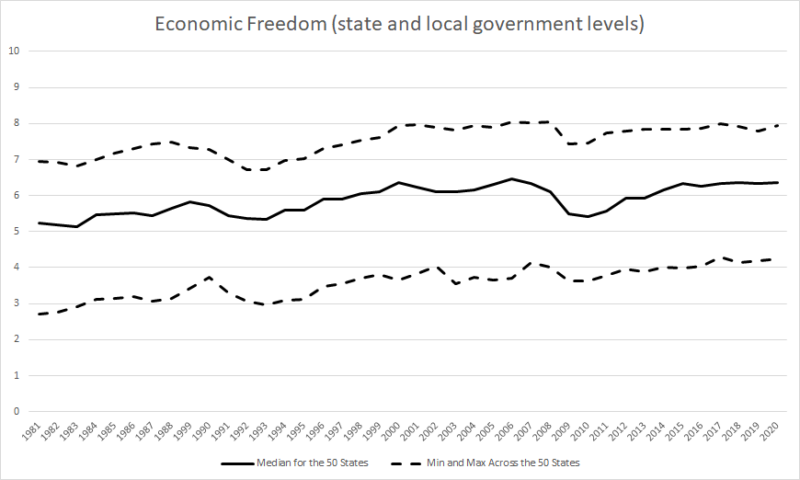
It’s reasonable to assume that small states would be more economically free because small states don’t require the massive government spending on infrastructure and social welfare programs that come with large populations and more complex economies. Yet, economic freedom scores don’t follow a pattern according to state size.
Two of the most economically free states, Florida and New Hampshire, are at opposite ends of the size spectrum. Florida is the third-largest state by population and fourth by economy. New Hampshire is the 42nd-largest by population and 40th by economy. So too, two of the least-free states, New York and Vermont, are of opposite sizes. New York is the fourth-largest state by population and third-largest by economy. Vermont is the third-smallest by population and second-smallest by economy.
But economic freedom does follow a consistent pattern when it comes to socioeconomic outcomes. This pattern becomes clear when, for each year, we divide the states into two groups according to the median economic freedom score in that year. For each year from 1981 through 2020, let’s call the 25 states that scored above the median, the “more free” states for that year, and the 25 that scored below the median, the “less free.” So divided, we can compare in each year economic measures that matter the most to people: unemployment, poverty, income, and income inequality.
From 1981 through 2020, one-quarter of the fifty states (Florida, New Hampshire, South Dakota, Texas, Tennessee, Virginia, Georgia, North Carolina, Idaho, Indiana, Missouri, and Colorado) appeared among the 25 more free states every year. Over that same period, one-quarter of the states (New York, California, Vermont, Oregon, Maine, West Virginia, Rhode Island, Alaska, Minnesota, Ohio, Michigan, and Washington) appeared among the 25 less free states every year. The remaining half of the states moved back and forth between the two groups, ranking among the more-free states in some years and among the less-free in other years.
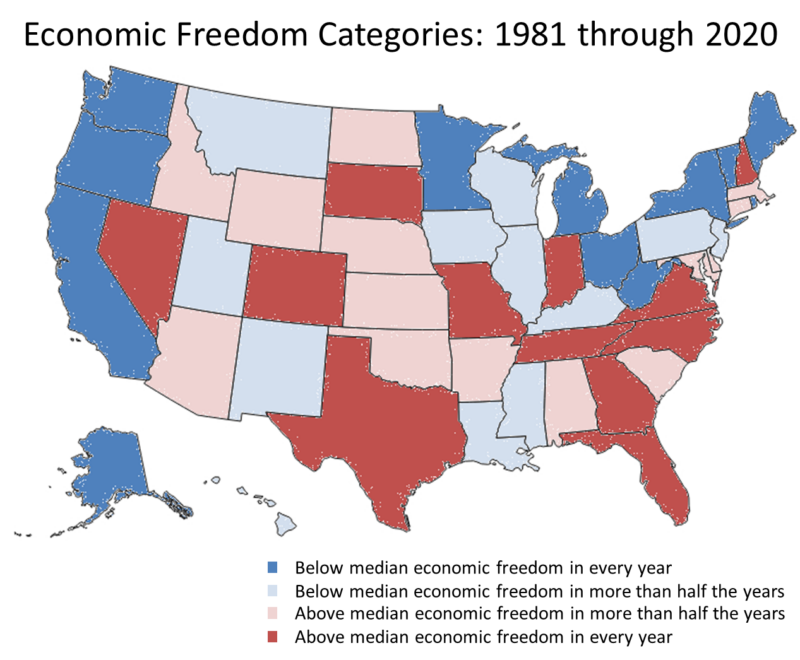
Consider unemployment rates across the states. In 1981, for example, the average unemployment rate among the 25 states in the “less free” category was 7.8 percent. That same year, the average unemployment rate among the 25 states in the “more free” category was 6.7 percent. In 1982, the average unemployment rate for the less free states was 9.5 percent versus 8.8 percent for the more free states.
In each year of the past four decades, the less-free states in a given year had an average unemployment rate that exceeded that of the more-free states in that same year. From 1981 through 2020, average unemployment was almost a full percentage point lower in the more-free states. For four decades, we’ve seen solid evidence that more economic freedom and lower unemployment rates go together.
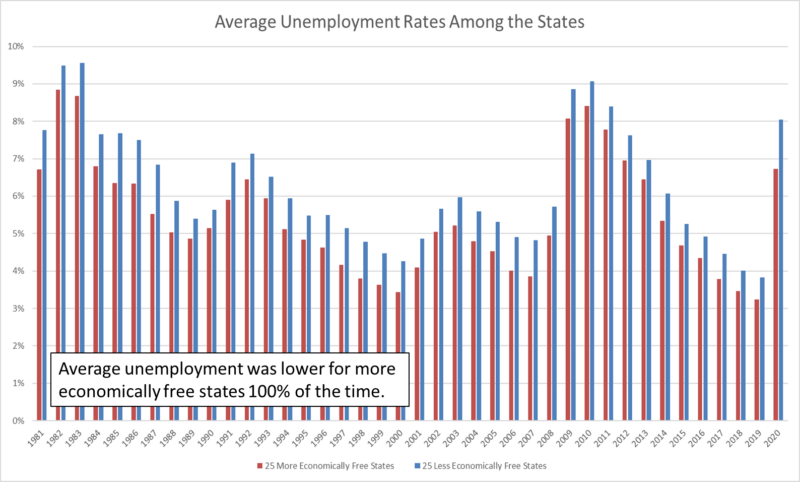
From 1981 through 2020, the average poverty rate across states was lower among the more-free states 65 percent of the time. Median household income was higher among the more-free states 60 percent of the time. And when we adjust household incomes to account for differences in the costs of living across the states (cross-state cost of living adjustments only go back to 2008), the more-free states showed higher average household purchasing power 85 percent of the time. Interestingly, income inequality (for which data also only go back to 2008) was lower for the more-free states 60 percent of the time.
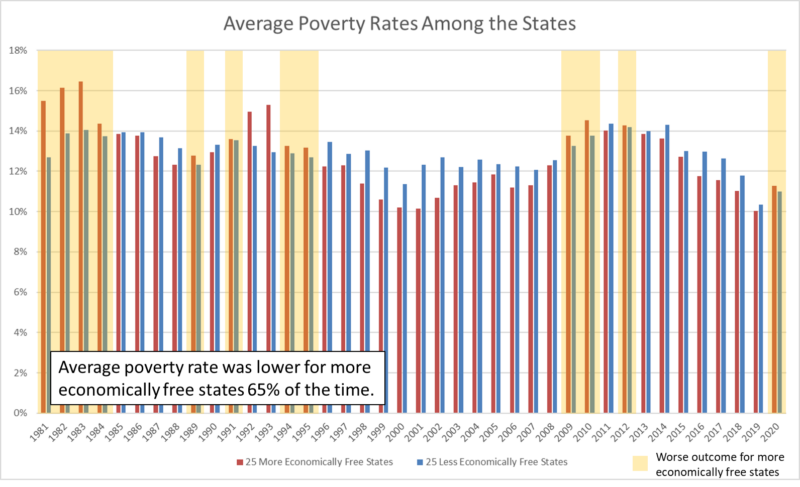
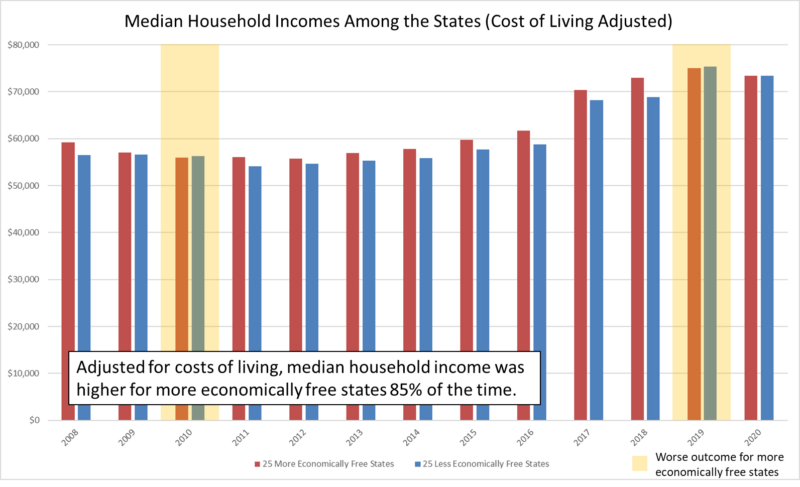
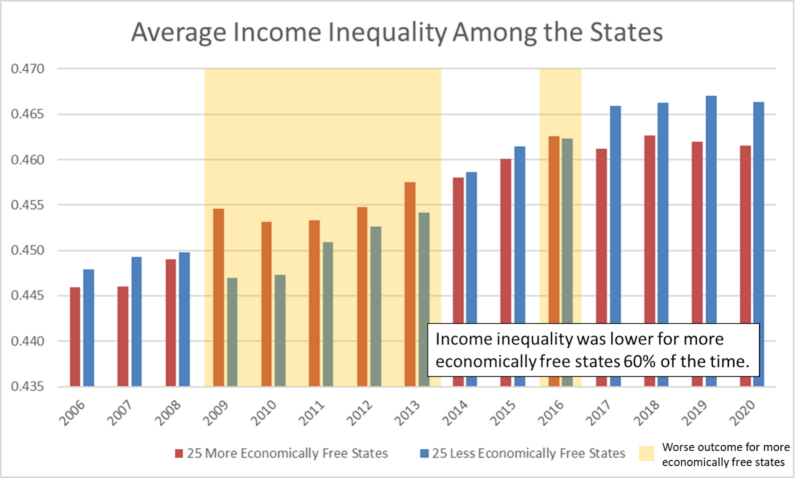
While these results may come as news to non-economists, they aren’t to economists who study economic freedom, because the same pattern repeats whether we’re comparing states or cities or countries. When comparing countries, the evidence becomes richer still as more-free countries exhibit lower child labor rates, more gender equality, and better environmental outcomes. And this isn’t a “rich” country effect, because the same pattern emerges when comparing poor-and-more-free countries to poor-and-less-free countries.
Of course, the data only show correlations, and correlation isn’t causation. But, the absence of correlation is the absence of causation. And nowhere do we see a correlation between less economic freedom and better outcomes. That is, we have evidence that less economic freedom does not cause better outcomes.
The sad irony is that, when faced with unemployment, poverty, and inequality, voters most often ask what the government can do to mitigate these problems. But the data suggest that, just as often, voters should be asking what the government can stop doing that is exacerbating these problems.
The four most recent decades of evidence support the claim that Thomas Jefferson made twenty-two decades ago: societies achieve the best outcomes when their governments prevent people from harming each other, but otherwise leave them alone.
***
This article was originally featured on AIER.org.





